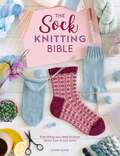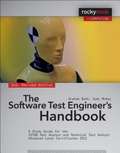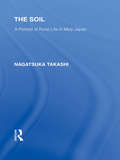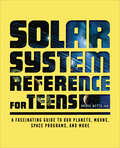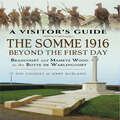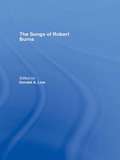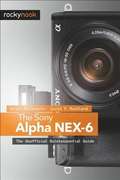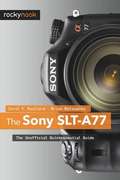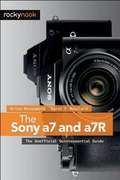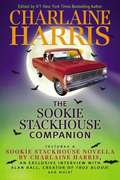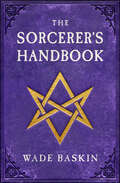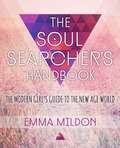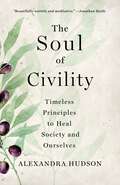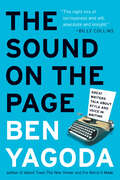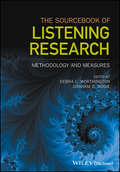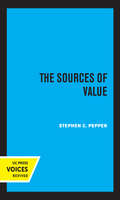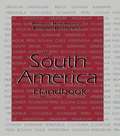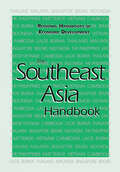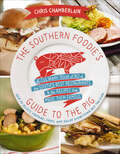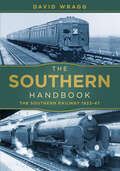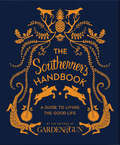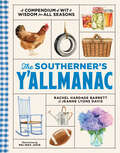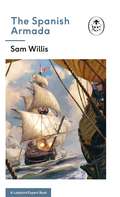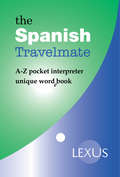- Table View
- List View
The Sock Knitting Bible: Everything you need to know about how to knit socks
by Lynne RoweThe definitive guide to knitting cozy, colorful socks, covering every aspect for knitters of all abilities.The Sock Knitting Bible is the ultimate reference for sock knitting skills, techniques, materials, projects, and more. Here you'll find in-depth information on everything from sizing and yarn to casting on and color-work. Whether you want to knit toe up, cuff down or even two at a time socks, this comprehensive volume covers it all.There are step-by-step instructions for all the various sock knitting techniques, as well as three basic sock patterns that even an absolute beginner can follow. Author Lynne Rowe also looks at the different kinds of tools available, from double pointed needles and small circular needles to innovative products such as flexible DPNs.And it all comes together with ten delightful projects by some of the most exciting and talented sock designers. Here you will find patterns for stripes, fair isle, cables, lacy, sparkly and snuggly socks: an array o pattern for all your sock-knitting needs!
The Software Test Engineer's Handbook
by Judy Mckay Graham BathRevised and updated 1st Edition, 2011 There are a lot of books around covering functional testing techniques, but relatively few cover both functional and technical testing. This book will fill that gap. Authors Graham Bath and Judy McKay are core members of the ISTQB Working Party that created the new advanced level syllabus, which will be rolled out worldwide this year. This book brings both functional and technical aspects of testing into a coherent whole, which will benefit not only test analyst/engineers but also test managers. Based on the "Certified Tester" Advanced-Level syllabus issued by the ISTQB in 2007, the book covers everything you will need to know to successfully sit the examinations for Test Analyst and Technical Test Analyst. For those planning to take one or both of these exams, the book provides a solid base for preparation and clearly indicates which sections apply to which specific examination.
The Soil: A Portrait of Rural Life in Meiji Japan (Routledge Library Editions: Japan)
by Nagatsuka TakashiThis is a selection of the best plays of Chikamatsu, one of the greatest Japanese dramatists. Master of the marionette and popular dramas, he had, until the publication of this book, remained unknown to western readers owing to the difficulty of translating the work into English. The introduction provides a comprehensive survey of the history of Japanese drama which will assist the reader in better understanding the plays.
The Solar System Reference for Teens: A Fascinating Guide to Our Planets, Moons, Space Programs, and More
by Dr. Bruce BettsTake a tour of our solar system with this guide for teens ages 12 to 16 From the moons of Jupiter to the surface of Mars, our solar system is home to a multitude of wild, weird worlds. Crack open this solar system book and embark on a journey through space as you meet key figures in history, explore careers in astronomy, uncover some of the solar system's biggest mysteries, and more. Tons of images—Bring celestial objects into focus through more than 160 images, illustrations, and diagrams that provide a close-up look into our solar system and how it works. Fascinating facts—Did you know the Moon gets farther from Earth each year at about the same rate that your fingernails grow? Discover all sorts of awe-inspiring facts about our solar system's planets, moons, and more. Exciting exploration—Learn about important historical achievements and technological developments—including missions to different parts of the solar system—and get tips for your own stargazing sessions. Explore all the cool stuff in our solar system with this accessible reference guide for teens.
The Somme 1916—Beyond the First Day: Beaucourt and Mametz Wood to the Butte de Warlencourt (A Visitor's Guide)
by Jon Cooksey Jerry MurlandIn their second Visitor’s Guide to the 1916 Battle of the Somme Jon Cooksey and Jerry Murland focus on the series of secondary battles that were key stages in the five-month struggle that followed the start of the offensive on 1 July. They take the visitor – and the reader – across the entire battlefield, covering in graphic detail sites where actions took place that are almost as famous as the Somme itself in the history of the First World War, including Mametz Wood, High Wood, Deville Wood, Guillemont, Ginchy, Pozieres and Flers. They also provide tours of the less-well-known but equally interesting sites which played important parts in the offensive as a whole. In a sequence of routes that can be walked, biked or driven they describe what happened in each place, identify the units involved, highlight the experience and exploits of individual soldiers, and point out the notable sights, monuments and cemeteries. This highly illustrated guidebook is essential reading for visitors who wish to enhance their understanding of the Battle of the Somme and the war on the Western Front. It is also the ideal companion volume to The First Day of the Somme: Gommecourt to Maricourt by the same authors.
The Songs of Robert Burns
by Donald A. LowIn this definitive work for our generation, Donald Low brings together, for the first time, the words and tunes of all Burns' known songs, both `polite' and bawdy. The Songs of Robert Burns were, in their author's eyes, the crown of his achievement as a poet. After years of study and investigation, many hours spent listening to old airs, as he recalled the living, daily, song-life of the people of Scotland, and through the creation of some of the finest lyric poetry produced in the British Isles, Burns' success is beyond doubt.
The Sony Alpha NEX-7
by Brian Matsumoto Carol F. RoullardThe Sony Alpha NEX-7: The Unofficial Quintessential Guide provides a wealth of experience-based information and insights for owners of this exciting new camera. Authors Carol F. Roullard and Brian Matsumoto team up to help the new user navigate past the confusion factor that often comes with complex and powerful camera equipment. This book explores the features and capabilities of the camera in a way that far surpasses the user's manual. It guides you through the camera features with step-by-step setting adjustments and detailed how, when, and why explanations for each option. Every button, dial, switch, and menu configuration setting is explored in a friendly manner, with suggestions and tips for setup according to various shooting styles. The informative text is illustrated with screenshots and example images throughout, making it easy to follow along. The authors cover everything from the basic features of the camera to numerous advanced photographic applications. The first section of the book teaches the new user to start taking pictures immediately by using the camera's Intelligent Automatic mode. The second section covers how to begin taking more control by switching to the semi-automatic modes. Finally, you'll learn to take full manual control of the camera, allowing you to break some "rules" and capture images that are a unique reflection of your creative personality. Carol and Brian go beyond just the camera itself and share how third-party software and optional accessories can improve on the camera's standard commands. You'll even learn how the electronic viewfinder, the fixed mirror, and Sony's novel shutter design improve the camera's utility for critical scientific photography (i.e., photomicrography and photography through the telescope).The Sony Alpha NEX-7: The Unofficial Quintessential Guide will allow you to really take control of your camera, to push the envelope, and to have fun.
The Sony SLT-A77
by Brian Matsumoto Carol F. RoullardThis book provides enthusiastic photographers with a wealth of information about the unique features of the Sony SLT-A77, an interchangeable-lens camera with an electronic viewfinder and a fixed, translucent mirror. The A77 differs from the current crop of DSLRs in its ability to use a phase detection focusing system throughout the entire picture-taking process, for both still photographs and videos. This provides an immediacy and responsiveness when using burst shots and creating HD videos that is unavailable in any other camera. In this guide, authors Carol Roullard and Brian Matsumoto teach you how to obtain exceptional photographs and videos as they cover everything from the basics of using the camera's automatic modes, to the more advanced aperture-priority, shutter-priority, program, and manual exposure modes. You'll also learn how best to take advantage of features such as the built-in dynamic range adjustment, sweep panoramic, GPS, colorization modes, facial detection and recognition, multiple shot exposures, and HD video. The authors provide you with an opportunity to improve your skills even further by discussing how third-party software and accessories can improve Sony's standard commands. You'll also learn about how the electronic viewfinder, fixed mirror, and Sony's novel shutter design improve the camera's utility for scientific photography through the microscope and telescope. Additional topics include:Advantages of the electronic viewfinder for previewing your photographs Using the accessory Sony shoe-mount flash Advantages of using the JPEG file format Advantage of having a fixed mirror and electronic first curtain shutter Settings for using the camera on a microscope and telescope Using the older Minolta Maxxum lenses
The Sony a7 and a7R
by Brian Matsumoto Carol F. RoullardThis book is a guide to using the Sony a7 and a7R, the first full frame, autofocus system cameras. At half the weight of a full frame DSLR, they are easy to carry for photographers on the go. The less-expensive a7 has a 24-megapixel sensor for shooting rapidly changing scenes; the a7R has a 36-megapixel sensor designed for ultimate image sharpness. Both use advanced image-processing algorithms and can use any manufacturer's lens when matched with the appropriate adapter. The electronic viewfinder gives the photographer an accurate preview of the image, ensuring the capture of technically excellent photographs by preventing mistakes in color temperature, depth of field, and exposure. All features of the a7 and a7R are covered, including automatic stitching to create panoramas, and multi-shot noise reduction that allows the use of extremely high ISOs. This book guides the photographer in using both the camera's automated features and manual controls to take photographs that are a unique reflection of his or her creative personality.
The Sookie Stackhouse Companion: A Complete Guide to the True Blood Mystery Series (The Southern Vampire Mysteries)
by Charlaine HarrisCharlaine Harris has topped the bestseller charts and become a nationwide phenomenon, thanks to the unconventional, and otherworldly, life of Sookie Stackhouse. Now take a closer look at Sookie and at her family, friends, enemies, adventures, and--of course--the lovers who set her world on fire.... Visit Bon Temps, the small Louisiana town that Sookie calls home, with a detailed map created by Charlaine herself, and learn the characteristics of the supernaturals who live there: vampires, two-natured, and fae. Examine all the branches of Sookie's family tree. And eavesdrop on the private conversations between rival vampires Eric and Bill. Also, enjoy the compelling novella "Small-Town Wedding," in which Sookie accompanies her shapeshifting boss, Sam, to his brother's wedding in Texas, where happily-ever-after seems very far away.... Exclusive interviews with True Blood creator Alan Ball and author Charlaine Harris--compiled from fan questions--will satisfy your craving for all things Sookie, as will trivia questions, recipes (including Caroline Bellefleur's famous chocolate cake!), and a concordance to the Sookie Stackhouse novels.
The Sorcerer's Handbook
by Wade BaskinThis alphabetical reference guide offers in-depth information on topics, terminology, and key figures from the history of sorcery and magic. Sorcery—the art of manipulating the supernatural forces that control the universe—has a long, rich, and fascinating legacy reaching back to ancient times. Any student or practitioner of this strange art will need a roadmap to its unique vocabulary and secret history. Drawn together from many different sources and presented in this book in simple terms are thousands of fascinating items relating to sorcery. Entries are arranged alphabetically and cross-indexed to provide ready access to the wide variety of materials associated with sorcery. Sorcery, as used in this book, embraces the precepts and practices through which men and women have sought to manipulate their universe.
The Soul Searcher's Handbook: A Modern Girl's Guide to the New Age World
by Emma MildonFrom healing crystals and meditation to aromatherapy and numerology, this fun and fresh beginner&’s guide to everything body-mind-spirit defines New Age practices for anyone embarking on a spiritual journey.What type of crystal should I put in my car for a road trip? Should I Feng Shui the apps on my phone? In this illuminating introduction for the modern-day witchy soul searcher, Emma Mildon shines light on everything your parents didn&’t teach you about New Age practices with the air of a knowledgeable and witty best friend. With something for every type of spiritual seeker, The Soul Searcher&’s Handbook offers easy tips, tricks, and how-tos for incorporating everything from dreamology and astrology to mysticism and alternative healing into your daily practices. Your one-stop shop for all things magical and enlightening—handy, accessible, entertaining, and packed with all the wisdom you need. So embrace the goddess within, dig your toes into the sacred soil of Mother Earth, and open your soul to your full potential. Regardless of what you&’re seeking, The Soul Searcher&’s Handbook is your number one guide to awakening a more fulfilled and soulful you.
The Soul of Civility: Timeless Principles to Heal Society and Ourselves
by Alexandra HudsonAlexandra Hudson, daughter of the "Manners Lady," was raised to respect others. But as she grew up, Hudson discovered a difference between politeness—a superficial appearance of good manners—and true civility. In this timely book, Hudson sheds light on how civility can help bridge our political divide.From classical philosophers like Epictetus, to great twentieth-century thinkers like Martin Luther King Jr., to her own experience working in the federal government during one of the most politically fraught eras in our nation's history, Hudson examines how civility—a respect for the personhood and dignity of others—transcends political disagreements. Respecting someone means valuing them enough to tell them when you think they are wrong.It’s easy to look at the divided state of the world and blame our leaders, the media, or our education system. Instead, we should focus on what we can control: ourselves. The Soul of Civility empowers readers to live tolerantly with others despite deep differences, and to rigorously protest wrongs and debate issues rather than silencing disagreements. A robust public discourse is essential to a truly civil society, and respecting others means telling hard truths. If enough of us decide to change ourselves, we might be able to change the world we live in, too.Provocative, personal, and acutely relevant, The Soul of Civility is an essential book for our era.
The Sound of Music: The Making of America's Favorite Movie
by Julia Antopol HirschWhen The Sound of Music was released in 1965, it took the world by storm, capturing five Oscars (including Best Picture) and holding the number-one spot box-office record for five years. For millions of viewers, the film is a rare combination of a powerful and moving story, superb music, and breathtaking scenery. The Sound of Music: The Making of America's Favorite Movie is not only an unequalled tribute to this beloved movie musical but also the most complete behind-the-scenes account of the creation of this Hollywood classic. Through exclusive, in-depth interviews with Robert Wise, Ernest Lehman, Saul Chaplin, Julie Andrews, Christopher Plummer, Kym Karath, Johannes von Trapp, Richard Zanuck, and dozens of other cast and crew members; over 200 stills from the movie's most memorable scenes; rare snapshots from personal scrapbooks; and papers from the Fox Studio archives, Julia Antopol Hirsch has re-created the magic that is The Sound of Music:Julie Andrews's "first kiss" with Christopher Plummer, she recalls, was crazy, because neither of them could stop laughing.Plummer's after hours festivities with the nuns around the piano often went on way into the night.When she rushed up the mountain for the famous opening scene, Julie Andrews kept getting knocked to the ground by the downdraft from the cameraman's helicopter.Yul Brynner, Walter Matthau, and Sean Connery were all considered for the role of the Captain.Mia Farrow, Sharon Tate, and Richard Dreyfuss auditioned for juvenile roles.Director Robert Wise, under pressure from Fox's Richard Zanuck for being over budget, almost didn't finish the location shoot in Austria because it simply wouldn't stop raining.Now completely updated and in full color throughout, this engaging volume is both an insider's guide to and a delightful celebration of "the happiest sound in all the world!"
The Sound on the Page: Great Writers Talk about Style and Voice in Writing
by Ben YagodaThe acclaimed author examines the importance of a writer&’s voice—including interviews with Susan Orlean, Michel Chabon, Junot Díaz and others. In writing, style matters. Our favorite writers often entertain, move, and inspire us less by what they say than by how they say it. In The Sound on the Page, acclaimed author, teacher, and critic Ben Yagoda offers practical and incisive help for writers on developing and discovering their own style and voice. This wonderfully rich and readable book features interviews with more than 40 of our most important authors discussing their literary style, including: Dave Barry Harold Bloom Supreme Court Justice Stephen Breyer Bill Bryson Michael Chabon Andrei Codrescu Junot Díaz Adam Gopnik Jamaica Kincaid Michael Kinsley Elmore Leonard Elizabeth McCracken Susan Orlean Cynthia Ozick Anna Quindlen Jonathan Raban David Thomson Tobias Wolff
The Sourcebook of Listening Research: Methodology and Measures (Handbooks In Communication And Media Ser.)
by Debra L. Worthington Graham D. BodieWinner of the 2018 Distinguished Book Award from the Communication and Social Cognition Division of the National Communication Association.Essential reading for listening researchers across a range of disciplines, The Sourcebook of Listening Research: Methodology and Measures is a landmark publication that defines the field of listening research and its best practices. the definitive guide to listening methodology and measurement with contributions from leading listening scholars and researchers Evaluates current listening methods and measures, with attention to scale development, qualitative methods, operationalizing cognitive processes, and measuring affective and behavioral components A variety of theoretical models for assessing the cognitive, affective, and behavioral facets of listening are presented alongside 65 measurement profiles Outlines cutting-edge trends in listening research, as well as the complexities involved in performing successful research in this area
The Sources of Value
by Stephen C. PepperThis title is part of UC Press's Voices Revived program, which commemorates University of California Press’s mission to seek out and cultivate the brightest minds and give them voice, reach, and impact. Drawing on a backlist dating to 1893, Voices Revived makes high-quality, peer-reviewed scholarship accessible once again using print-on-demand technology. This title was originally published in 1958.
The South America Handbook (Regional Handbooks of Economic Development)
by Patrick Heenan Monique LamontagneFirst Published in 2002. Routledge is an imprint of Taylor & Francis, an informa company.
The Southeast Asia Handbook (Regional Handbooks of Economic Development #Vol. 3)
by Greg Bankoff Michael Haas Patrick Heenan Monique LamontagneThe Regional Handbooks of Economic Development series provides accessible overviews of countries within their larger domestic and international contexts, focusing on the relations among regions as they meet the challenges of the twenty first century.The series allows the non-specialist student to explore a wide range of complex factors-social and political as well as economic-that affect the growth of developing regions in Asia, Europe, and South America. Each Handbook provides an overview chapter discussing the region's economic conditions within an historical and political context, as well as 20 or more chapter-length essays written by recognized experts, which analyze the key issues affecting a region's economy: its population, natural resources, foreign trade, labor problems, and economic inequalities, and other vital factors.In addition, the volumes offer useful support materials, including a series of appendices that include a detailed chronology of events in the region, a glossary of terms, biographical entries on key personalities, an annotated bibliography of further reading, and a comprehensive analytical index.
The Southern Foodie's Guide to the Pig: A Culinary Tour of 50 of the South's Best Restaurants & the Recipes That Made Them Famous
by Chris ChamberlainA guide to purchasing, preparing, and cooking pork using the culinary traditions of the American South—includes photos, recipes and dining recommendations.Discover some of the essential tips and recipes behind the best pork dishes in the south with Chris Chamberlain, author of the popular The Southern Foodie Cookbook.Arguably the most democratic of all proteins, pork is welcome across the country from a gourmet pork belly dish on the menu of the toniest Charleston bistro to a whole hog roasting in a hole dug in the sand of a beach in LA (Lower Alabama).A geographic tour of the Southern states will showcase restaurants in the region that have special talents when it comes to pork. The chefs and pitmasters have shared some of their most sacred secrets, the actual recipes for the best pork, barbecue and bacon dishes that emerge from their kitchens.Since man cannot live by pig alone, there is also a selection of recipes that are great accompaniments to the pork dishes contributed by the fifty Southern restaurants that are featured.The Southern Foodie’s Guide to the Pig introduces readers to all the parts of this versatile animal and teaches procedures to prepare all sorts of wonderful dishes.
The Southern Handbook: The Southern Railway 1923-1947
by David WraggThe Southern Railway may not have been the most glamorous of the ‘Big Four’ companies that emerged from the grouping of 1923, but it was the great innovator. In the 1930s the Southern pioneered the first main-line electrification and created the largest electrified suburban railway network in the world. It was also one of the few to offer regular departures and the first to run true international services, introducing the ‘Night Ferry’ through-trains from London to Paris using special ferries. Forming part of a series, along with The GWR Handbook, The LMS Handbook and The LNER Handbook, this new edition provides an authoritative and highly detailed reference of information about the Southern Railway.
The Southerner's Handbook
by Editors of Garden GunWhether you live below the Mason Dixon Line or just wish you did, TheSoutherner's Handbook is your guide to living the good life. Curated by the editors of the award-winning Garden & Gun magazine, this compilation of more than 100 instructional and narrative essays offers a comprehensive tutorial to modern-day life in the South. From Food and Drink to Sporting & Adventure; Home & Garden to Style, Arts & Culture, you'll discover essential skills and unique insight from some of the South's finest writers, chefs, and craftsmen--including the secret to perfect biscuits, how to wear seersucker, and to the right way to fall off of a horse. You'll also find: Roy Blount Jr. on telling a great story; Julia Reed on the secrets of throwing a great party; Jonathan Miles on drinking like a Southerner; Jack Hitt on the beauty of cooking a whole hog; John T Edge on why Southern food matters; and much more. As flavorful, authentic, and irresistible as the land and the people who inspire it, The Southerner's Handbook is the ultimate guide to being a Southerner (no matter where you live).
The Southerner's Y'allmanac: A Compendium of Wit & Wisdom for All Seasons
by Rachel Hardage BarrettCelebrate southern living with this beautiful seasonal almanac chock-full of 100+ fun and practical ideas for decorating, entertaining, cooking, and gardening.With 150+ stunning photos and illustrations, and charming Southern witticisms, it&’s the perfect gift for anyone who loves the South.Southern charm abounds in this lighthearted compendium to what makes the region so very special. Created by lifelong southerners Rachel Hardage Barrett, editor in chief of Country Living, and Jeanne Lyons, their insider&’s guide includes:Entertaining ideas for any occasion from casual porch parties to an off-to-the-races Derby party and spirited gameday tailgates Southern interiors inspiration including welcoming kitchens, laid-back living spaces, and brake-worthy exteriorsWit and wisdom from prominent Southerners including how to wear seersucker to the art of selecting a monogramFresh twists on Southern recipes including Cheerwine Ribs, Pimento Cheese Deviled Eggs, and Hummingbird Bundt CakeNew ways to enjoy the garden from must-grow tomatoes to ways to display your favorite bloomsDelightful small-town escapes including the region&’s best U-pick farms, must-see soda fountains, and can&’t miss county fairOrganized by seasons, it's the quintessential southern gift book (and housewarming present!) for anyone who loves the South.
The Spanish Armada: A Ladybird Expert Book (The Ladybird Expert Series #30)
by Sam WillisPart of the ALL-NEW LADYBIRD EXPERT SERIES.____________Why did the Spanish launch their Armada on England?How did Francis Drake counter the Spanish threat?And why were so many ships lost at sea?In 1585 Spain was the most POWERFUL Empire in the known world.As tensions between PROTESTANT England and CATHOLIC Spain rose . . . SPAIN decided to INVADE ENGLAND. And launched the SPANISH ARMADA This raises the question: how did England manage to overthrow the Spanish invasion? Was it luck or judgement? Discover the answers and more inside Sam Willis's Ladybird Expert - The Spanish Armada, the thrilling and accessible account that explains what happened, who the key figures were and the tactics, triumphs and failures on both sides . . .
The Spanish Travelmate
by Lexus Alicia de Benito Harland Mike HarlandThe Spanish Travelmate phrasebook and dictionary gives you a detailed yet easy-to-use A to Z list of English words and phrases with Spanish translations for quick-find reference. There are more than 3500 words and phrases, and the Spanish translations come together with an easy-to-read pronunciation guide. Tap a hyperlink (there are hundreds of them) to go to special sections: travel tips about being in Spain; basic language notes; typical Spanish replies to your Spanish questions; conversion tables. These are features which make the Travelmate the must-have ebook Spanish phrasebook download for the traveller who wants to really communicate. The Spanish Travelmate phrasebook and dictionary also gives you a detailed Spanish menu reader of over 500 items and a dictionary section with translations of over 300 common Spanish signs and notices. This is the little book that's a big help. And a joined-up language experience.
